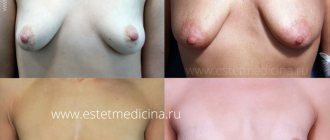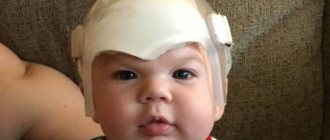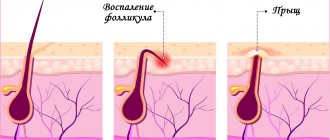Prominent ears in children is a congenital anatomical feature, which manifests itself in an increase in the angle of ear distance. In this situation, the size and shape of the ears are normal, but they are located almost at a right angle to the temple bone. Prominent ears usually do not harm the child’s health, but complexes may appear due to it. Therefore, many parents try to correct this physiological feature of their child at an early age.
Inheritance or acquisition?
Prominent ears are an overgrowth of the cartilage tissue of the auricle or a violation of the angle of attachment of the cartilage, that is, an anatomical feature. Most often it is a family “trait”. True, there is also a version that protruding ears are formed due to incorrect presentation of the fetus during pregnancy. But it is controversial, many experts disagree with it.
Some parents believe that slight protruding ears can be corrected at an early age by “gluing” the ears to the head with a medical plaster at night... A naive misconception! And unsafe: the patch can cause deformation of the auricle and inflammatory processes on the skin. Without otoplasty - plastic surgery - correction is impossible.
Causes
There are the following reasons for the appearance of protruding ears in children:
- heredity. This is the most common cause of protruding ears. It is caused by a genetic mutation that the baby inherited from an ancestor. There is no way to prevent such a deviation. And it’s the hardest thing to remove;
- intrauterine pathology. In this case, the fetus's ear deviates and becomes thicker. Theoretically, this phenomenon can be prevented, but there is no appropriate technology yet;
- during childbirth. Most rarely, protruding ears can appear in a child during childbirth. For example, during a caesarean section, when the woman in labor is pressed on her stomach. Also, a narrow pelvis and incorrect position of the fetus can lead to the appearance of this deviation;
- injuries. In children of different ages and in adults, protruding ears can develop as a result of injury;
- microtia. On the Internet you can find many photos of microtia, which depict underdeveloped children's ears. This happens due to vascular diseases, with Recklinghausen's neurofibromatosis, intensive growth of facial bones, isolated accelerated growth of the ear concha.
Scalpel and laser
The operation goes like this: a small incision is made from the “underside” of the ear so that there are no visible traces left later. The cartilage is released and trimmed. The operation is performed either with a conventional scalpel or with a laser. The laser allows you to act more accurately and precisely. Another advantage over a traditional scalpel is that the laser beam, cutting the tissue, immediately “seals” the blood vessels, so there is practically no blood loss. The cartilage is fixed in a new place, cosmetic sutures are applied to the skin, and self-absorbable surgical sutures are used. The surface of the wound is treated with special antiseptic ointments and a sterile bandage is applied, and on top is a compression tape, similar to the one worn by tennis players on the court. The operation lasts on average about an hour.
Young patients are given general anesthesia, while adolescents undergo the operation under local anesthesia.
Otoplasty
First, let us note that there are a lot of lop-eared children in the world, and they live well with this feature. For some, with age, the angle of deviation of the ears decreases and the protruding ears disappear. However, if it interferes with the child’s normal life, then surgery can be performed.
Surgical correction of the conchae is called otoplasty and is usually performed on children as young as six years of age. It is done in a plastic surgery clinic or in a children's hospital with a referral from a doctor.
This plastic surgery is one of the easiest in terms of technology and postoperative period.
Children can sometimes have a problem such as tinnitus, this applies to any child.
Methods
Currently, there are more than two hundred methods of otoplasty. The most common of them are:
- traditional method. This is a common operation performed with a scalpel and other surgical instruments. For children under twelve years of age, otoplasty is performed under general anesthesia, after that - under local anesthesia. During the operation, the surgeon changes the shape of the cartilage and applies a special bandage. It should not be removed for several days to prevent deformation of the ears;
- laser method. Unlike traditional otoplasty, the operation is performed with a laser “scalpel”. This allows you to reduce the amount of blood (the vessels are immediately sealed) and disinfect the operated tissue.
Contraindications
Surgical correction of protruding ears is an operation. And, of course, it has some contraindications:
- HIV, syphilis, hepatitis B;
- period of infectious diseases - ARVI, influenza and others;
- skin problems in the ear area;
- diabetes mellitus and thyroid diseases;
- bleeding disorders;
- oncological diseases;
- acute phases of chronic diseases.
Rehabilitation and complications
The postoperative period of otoplasty is usually tolerated by children normally. The baby will take analgesics for the first couple of days after surgery. The doctor will also prescribe wearing a pressure bandage for three to seven days. For three weeks it is recommended to wear it at night.
Parents should lubricate the seams on their ears with products prescribed by the doctor. The suture material is removed after ten to fourteen days. After the operation, the ears should not be exposed to physical, thermal or ultraviolet effects for two months.
As for complications of otoplasty, their likelihood is extremely low if all the doctor’s instructions are followed. However, sometimes they happen. For example:
- suppuration. If you notice signs of suppuration in the operated ears, inform your doctor immediately. Mild suppuration is cured in a couple of days;
- colloid scars. They may occur due to the characteristics of the child’s skin;
- discharge of the conchae of the ears. If you do not take care of your child's operated ears, a repeat operation may be required.
Important
How to prepare for otoplasty?
Before the operation you must do:
>> Clinical blood test with determination of platelet count and clotting time. >> Biochemical blood test. >> Blood test for infections (hepatitis A, C virus, etc.). >> General urine test. >> Electrocardiogram.
And:
>> Consult your pediatrician. >> Bring your baby to surgery on an empty stomach.
In infants
Development
The fetal ears begin to develop in the third month of pregnancy. By the sixth month of pregnancy, the folds and relief of the ear begin to form.
As soon as the baby is born, protruding ears will be immediately visible. In infancy, it can be corrected without resorting to surgical methods. There are several ways to do this, which we will discuss below.
Correction
Conservative methods for correcting protruding ears have been developed for infants. Most popular:
- bandage. Using this method, babies no more than six months old can have protruding ears removed. It is at this time that the baby has soft cartilage tissue that can be corrected. Regular hats are great for correcting slight protruding ears. Some mothers put scarves on their babies' heads. Many people successfully use ear patches to prevent protruding ears;
- the deviation is corrected by the Arilis corrector. This is a special product at an affordable price that allows you to correct protruding ears in newborns in just three months. On the official website, a set of four items costs nine hundred and fifty rubles;
- corrector "Otostik". These ear correctors are made in Spain. Parents can use them as soon as the baby is three months old. The “otostik” is attached to the ears with special glue. The cost of a set of eight correctors is about two thousand rubles;
- corrector "Oto-plastic". This corrector is similar to the previous one, but is produced in the United Arab Emirates, in the city of Dubai. A set of thirty components costs four thousand two hundred rubles.
Expert recommendations
- It is possible to correct protruding ears in a baby without surgery only up to six months. This is then done using otoplasty.
- Many mothers glue the baby's ears with adhesive tape or tape. This measure is useless and will only bring discomfort to the child. To correct the shape of the ears, special correctors are used, which can be purchased at the pharmacy.
0 0 votes
Article rating
Point of view
Pro & contra
Marina, mother of 4-year-old Nadya:
– My daughter got my ears: they don’t puff up very much, but we will definitely operate! I suffer terribly because of this defect: I’ve worn the same hairstyle all my life, I’m afraid of the wind accidentally exposing my ears, I can’t wear earrings. But, unfortunately, I can’t have surgery due to my health. But my daughter has no contraindications, I can’t wait until she grows up to the correction, I don’t want to condemn her to the same problems.
Tatiana, mother of 8-year-old Dima:
– My son is teased at school because of his protruding ears. The boy is ready to do anything to get rid of this shortcoming. But my husband is categorically against otoplasty. I don’t know how to convince him yet.
Oleg, father of 7-year-old Igor:
– Prominent ears are not a vice or a defect. She never bothered me in my life, although the guys tried to tease me at school. But I responded with ridicule and sometimes with fists. Nothing, they even respected me. Our son is still worried about his ears, but we are not even thinking about surgery. Let him learn to resist offenders!
The effectiveness of folk remedies for protruding ears
After analyzing “grandmother’s” advice and expert opinions, we assessed the effectiveness and safety of the most common folk methods for straightening protruding ears in a baby.
- While browsing the Internet for help, you may come across advice like: “Secure protruding ears to the child’s head with adhesive tape.” Is this method really effective?
Of course not! Even if you glue your baby's ears for months, it won't make a difference in the long run. However, if you decide to try it “because it won’t make it worse”, be careful - sticking a patch on it can have negative consequences. First of all, it is a source of great discomfort for the child. The baby will experience tension due to the glued patch. None of the adults would agree to such experiments on themselves, would they?
Secondly, prolonged presence of the patch on the skin can cause skin irritation and an allergic reaction. Not to mention the dubiously pleasant process of removing the bandage from your ears.
- The second way is to place the baby on one side. It is recommended to use this method when one ear is more protruding than the second. This method is also not recommended as it can lead to deformation of the child's skull. That is why doctors so often note that the child should be placed alternately on the right and left sides. It is important!
- The third way is to use ear bands. It’s difficult to talk about the disadvantages of using them, but one thing is for sure – it won’t help! Therefore, you should not put bandages on your child’s ears 24 hours a day.
It turns out that home methods against protruding ears are not effective, and some of them can even lead to negative consequences. But, nevertheless, I want to solve the problem. Is there an efficient way to do this?
Expert commentary
Psychologist Olga Vladimirova:
– Should I correct protruding ears or not? In my opinion, this is a very personal question, and not of the parents, but of the child himself. You cannot categorically impose your position on him. Even if protruding ears caused a lot of problems for a mother, this does not mean that her daughter will have the same problem. If a child is teased by his peers, yes, this can become a psychological problem for him. But try to understand its origins: perhaps protruding ears are only a momentary reason: peers simply see how sharply their friend reacts to teasing, so they pester him. Try to teach your child to respond to ridicule with a smile or a joke. Explain that the offenders will simply not be interested in “getting” him.
Reflections about one's own appearance usually begin in children during adolescence, and not at 6–7 years old. If this happened earlier, it is important to find out in a confidential conversation what exactly is bothering the child. And if it turns out that he is really worried precisely because of his protruding ears, then, of course, this defect needs to be corrected. It's hard to convince your dad, can't find any compelling arguments?
Consult a psychologist, tell us about the situation in the family, the character of your husband - a solution will probably be found.
What to do when your child's ears protrude
First of all, make sure that the problem is actually in the ears, and not... in the parents. We can talk about protruding ears when the distance from the tip of the ear to the skull is 2 or more centimeters. Ruler in hand and go! If your fears are confirmed, follow the plan below.
- When the child is already at preschool age, take care of good camouflage of protruding ears. Disguising hairstyles are perfect for lop-eared boys and girls; in addition, girls can wear decorative headbands.
- Don't laugh at your child and don't let others do it. Firmly and briefly stop any teasing about your baby's appearance. When your child is already in preschool age, encourage his self-esteem. When the baby comes in tears because someone called him names, talk to him about the disadvantages and advantages of each person. “Look, I have a funny toe and your ears are a little bigger. Despite this, we are both good people, and to me you are the most wonderful in the world.” Don't be afraid to bring up this topic with other children.
- Consider surgery. It can be done by a teenager. If you wish, you can have the operation done in a private medical facility. The cost is not prohibitively high. In some cases, if the child cannot withstand local anesthesia, you will need to pay extra for general anesthesia.
The last point is not at all mandatory. Many people live happily with their ears protruding and do not experience any discomfort from it, and their loved ones sincerely think they are cute.
Share
If a child twitches his ear, is he sick?
A child's habit of touching his ears does not necessarily indicate otitis media. The baby may simply be interested in exploring her ears, or she likes to pull on them, or her teething irritates the nerve endings and causes the baby to constantly pull on her ears. But if the baby’s increased interest in his ears is combined with crying, irritability, fever, runny nose, conjunctivitis, or a cold in general, you should take this signal seriously. Very often, intuition helps attentive mothers to notice and recognize an ear infection in a child in time - especially when they already know what it is and how it can manifest itself.
Why is it important to properly treat children's ears?
Your child's hearing depends on the proper vibration of the eardrum and the condition of other parts of the middle ear. Repeated infections can damage the eardrum, while the accumulation of fluid in the middle ear cavities negatively affects (sort of dampens) the vibration of the eardrum - ultimately, both interfere with the baby's normal hearing. This is why it is important to take ear infection treatment seriously, especially as your child learns to speak. Partial hearing loss can lead to delayed speech development or even pronunciation problems, which will later affect the child’s speech habits and success in learning.
Why are ear infections so common in children?
Let's take a look into the middle ear to understand why small ears so often suffer from pathogens. The canal, called the Eustachian (auditory) tube, connects the nasopharynx and the middle ear cavity and performs many important functions: it helps to compare pressure, provides ventilation and protection. But it is in the nasopharynx that most bacteria find nutritious moisture and a breeding ground. Since in a child the Eustachian tube is short, wide and placed horizontally, it is easier for mucous discharge from the throat and nose, as well as any microorganisms in them, to enter the middle ear cavity through it. The child’s immune system has not yet been fully formed, and therefore is vulnerable - it needs more time to fight many unfamiliar bacteria. This is how otitis media often develops in many young children.











